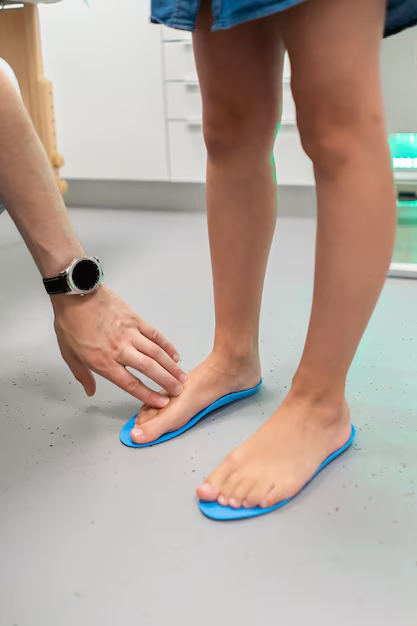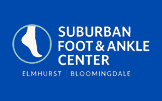
Foot Deformity Treatment at Suburban Foot & Ankle Center
Understanding Foot Deformities
Foot deformities are abnormalities in foot shape that lead to the pain, tilt, or gait disturbance. They can be congenital (from birth) or could be a result of lifestyle, injury, or other health condition.
Common Foot Deformities
Fallen Arches (Flat Feet): This is a deformity that takes place when the arch of the foot collapses. Hence, you might notice the foot’s contact surface is almost touching the ground. Nonetheless, researchers at the American Podiatric Medical Association (APMA) state that the likelihood of going through flat feet decreases as one grows out of childhood but flat feet can come along with chronic pain in the feet, ankles, and lower back for some adults.
Cavus Foot (High Arches): A cavus foot is when a person’s foot has an unusually high arch. Thus, the person might feel discomfort like the ball of the foot is being put too much pressure on it which might lead to pain and make it hard to find comfortable shoes. The condition may be related to neuromuscular diseases such as Charcot-Marie-Tooth disease (a disorder that occurs in the peripheral nerves of the body).
Bunions: They refer to the protrusion of the bone at the joint between the big toe and the foot. Improperly fitting shoes are the most common blame for this disorder. Mayo Clinic says they can cause pain, enlarge the bunion and you can have trouble walking. Behind the scenes, what is happening is that the joint becomes inflamed as a result of constant pressure on it.
Hammertoes: The incapability of one or more toes to line up straight may lead to hammertoes. This is evidenced by the fact that it causes discomfort and it will be troublesome to find shoes. The main reason is that a muscle, or tendon, or ligament from the toe is out of balance.

Non-Surgical Solutions for Foot Deformities
On the other hand, contrary to popular belief, there are numerous foot deformities that can be treated effectively without resorting to surgery. Through the utilization of non-invasive treatments, we do our best as the latest technology is at our disposal to cure painful conditions promptly thus going back to normal foot function.
Evidence-Based Treatment Options
- Custom-made Orthotics: Your podiatrist may suggest custom shoes that can be created to fit your feet the best way. You may wear them to fix your balance, support your arch, and remove the pain in conditions like flat feet and high arches among others.
- Bracing: To provide necessary aid to the foot, certain orthotic devices such as braces can be used for conditions such as ankle instability and after a surgical operation. This method is effective in reducing pain and preventing further complications.
- Padding and Splints: There is a type of special padding used to soften the tender areas of the foot, while a splint can realign the toes and in this case improve posture and function. This has been corroborated by the Mayo Clinic, cars of hammertoes, and bunions are usually made using these treatments.
- Physical Therapy: As per the National Institute of Arthritis and Musculoskeletal and Skin Diseases (NIAMS), doing exercises and stretches aimed at strengthening and balancing muscles will relieve pain and help prevent injuries in the future.
When to Seek Treatment for Foot Deformities
Not all foot deformities have to be treated immediately, but by avoiding care, you will open the door for more severe complications to develop. If you are having constant discomfort or are unable to move, it is time to get professional treatment, so that you can prevent future issues.
Signs You May Need Professional Treatment
- Ongoing Pain: Persistent foot or ankle pain that is not diminishing after a break or home remedy may signal the need for expert care. The APMA points out that foot disorders, if left untreated, might result in more complications, such as joint degeneration.
- Difficulty Walking or Standing: It is time to make a visit to the specialist if you find it difficult to walk, get up in the morning, or simply do everyday activities without being in more or less continuous pain in the feet or experiencing foot deformities.
- Visible Changes: You should have an appropriate expert review the feet if there are any prominent enough foot changes, like a bunion forming, or the arch dropping. The American Orthopaedic Foot & Ankle Society (AOFAS) advises you to start with an early intervention to prevent the condition from becoming worse.
- Shoe Fit Issues: It may be a good idea to consider the possibility of an underlying foot problem that needs treatment if you tend to feel pain when you put on shoes or those shoes are rarely comfortable for you.
Frequently Asked Questions About Foot Deformities
Here are some of the questions often heard around foot deformities and its treatments:
What causes foot deformities like flat feet and high arches?
Misshapen foot structures may come into being as it might be genetically concluded, occur from an injury, and also be a result of developing other medical conditions (like neuromuscular disorders or arthritis). Moreover, overexertion, obesity, and aging are the other factors that are also to blame for the apparition of such issues.
Can foot deformities be treated without surgery?
Yes, they can! Primarily, custom-made orthotics, bracing, and the application of physical therapy are effective non-surgical procedures. According to the American Podiatric Medical Association, the majority of foot deformities such as flat feet and high arches can be managed efficiently without the need for surgery.
How long does it take to treat foot deformities?
The duration of treatment is defined by the degree of the condition. Commonly, physical therapy and orthotics show signs of improvement in two weeks, but they may continue for several more months to get total relief. One good thing is, AAOS is of the opinion that desisting from the activity and following a prescribed treatment plan will help in reducing or eliminating the symptoms.
Will treatments improve my ability to walk?
Of course, in a more functional and mobile manner, treatments such as custom orthotics and physical therapy can help boost the range of motion. The main point in treating trauma early is to diminish the chances of getting ultimate disability.
Do you accept insurance for foot treatments?
Yes, we do! Most insurance plans are accepted at the Suburban Foot & Ankle Center. Please, contact us to get your coverage questions addressed.
